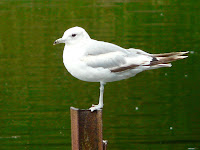I visited the Central Lakeland Fells during the week for a mighty circular route that encompassed Tarn Crag, High Raise, Sergeant Man, Thunacar Knott, Pavey Ark, and Harrison Stickle; starting and finishing in Grassmere. From Grassmere I headed up through Easedale and the Sour Milk Gyll to Easedale Tarn, then turned North to the steep climb up to Tarn Crag which is were I caught up with my main target for the day..... Mountain Ringlet. The Mountain Ringlet is an extremely rare species in England, with the population consisting of just a small number of locations in Cumbrian high plateaus, coupled with this its numbers can fluctuate widely from year-to-year, warm sunny days are needed to to persuade them to fly (which can be in short supply in the Lakes), and the adults only have a very short flight period; leading to this species being very 'hit-and-miss', however, I timed it just right and ended up finding very good numbers. On Tarn Crag alone I must have found 60+, with many more on plateaus around High Raise, Sergeant Man, and Thunacar Knott; all-in-all at least 110 could be seen (probably the most I will ever see in a day). They proved very difficult to photograph as the females were busy egg laying in the tightly packed grasses and the males wouldn't alight for long before they were off chasing rival males that entered their territory, in-fact the best chance to photograph one came from finding one with a damaged wing! A fantastic little butterfly that lives in one of the most stunning areas of the country (see the photos!).
Apart from the Mountain Ringlets, 3 Dark-Green Fritilary, 2 Pearl-Bordered Fritilary, Black Darter, 2 Golden-Ringed Dragonfly, 20+ Four-Spotted Chaser, Round-Leaved Sundew, Butterwort, Heath-Spotted Orchid, Peregrine, Kestrel, Buzzard, Pied Flycatcher, Whinchat, 3 Redstart, and a Dipper. Some great sightings and one of the best walks I have done in a long time.
 |
| Heath-Spotted Orchid - Easedale |
 |
| Sour-Milk Gyll, Easedale |
 |
| Easedale Tarn |
 |
| Codale Tarn from Tarn Crag |
 |
| Tarn Crag |
 |
| Perched Boulder on Pavey Ark |
 |
| Stickle Tarn and Pavey Ark |
 |
| Mountain Ringlet |
 |
| Mountain Ringlet |
 |
| Harrison Stickle from Pavey Ark |
 |
| Round-Leaved Sundew |
 |
| Kestrel - Harrison Stickle |
































